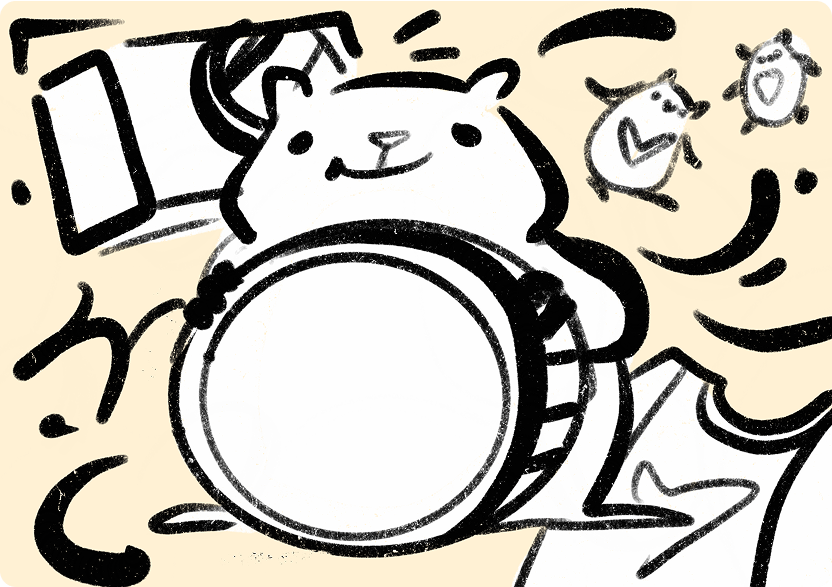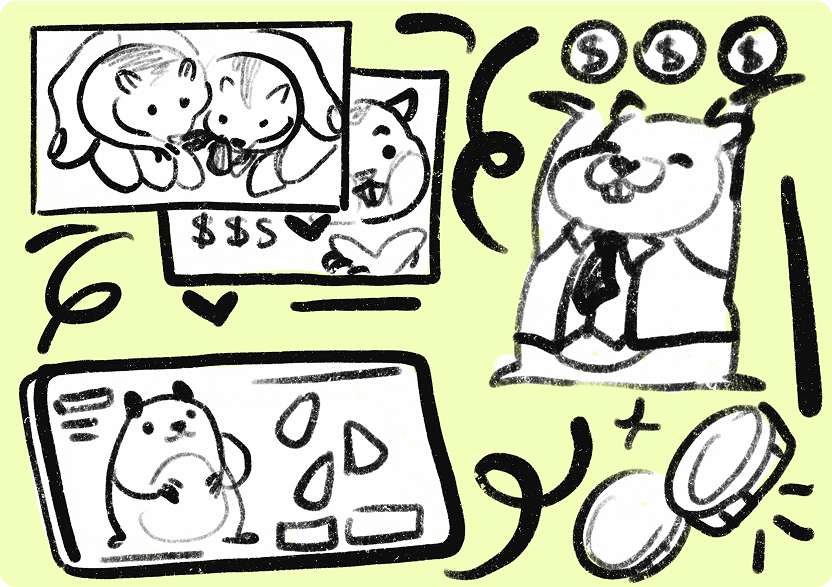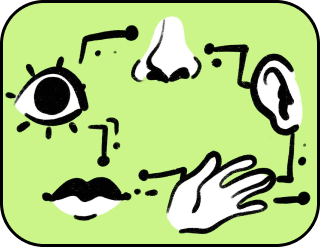Category: Life technologies
How to monetize a hamster
Old Ephraim’s mood left much to be desired. All evening he paced from corner to corner, painfully envious of other people’s successes, recalling yesterday’s school reunion. His usual way of life now seemed wrong, insufficient, underdeveloped. Everything annoyed him: from the still-sturdy Soviet furniture to the hamster, carelessly snoozing in its cage. Neither the vintage GDR tea set nor the lovingly assembled computer warmed his soul anymore.
In a turmoil of spirit, Ephraim stepped onto the balcony and voiced his problem out the open window.
‘Something has to change,’ he said.
‘What?’ rasped a voice from the neighbor’s side.
‘I don’t know. I need more money, I guess…’
‘Then change it!’ came the reply.
‘But how?’ asked Ephraim, gazing at the crimson horizon.
‘What do you have?’
‘I don’t know,’ Ephraim pondered. ‘I’ve got a computer. A hamster.’
‘Perrrfect! Use the hamster.’
‘What do you mean?!’ Ephraim turned toward the neighbor. But the window was empty. Only a large crow strolled along the narrow ledge.
‘Nonsense!’ cursed Ephraim, slamming the window shut.Hello, dear reader! Do you also think the bird’s advice is nonsense? Let’s try to look at the hamster monetization issue more broadly, as if it were a real economics textbook problem. So, our “given” is: one Ephraim, one Djungarian hamster named Steven, and one burning need to extract maximum financial profit from the rodent. If you think that’s impossible—let us prove you wrong. There is a way. In fact, more than one!
Falling asleep to the mumble of his old TV, Ephraim kept turning over the neighbor’s foolish suggestion. How could one possibly earn money from a hamster? The thoughts crept into his dreams, filling them with thousands of hamsters, each dropping golden coins. In the morning, Ephraim firmly decided to try making money off his hamster.
The first and most obvious solution—to sell Steven—was immediately rejected. A couple of dollars wouldn’t make a difference, even considering the monthly savings on feed and bedding. But the dream of gold-bearing hamsters wouldn’t leave his head, so he came up with a plan inspired by it: get Steven a mate and sell the offspring.
Surrounded by hamster-breeding manuals, Ephraim spent three remarkable months caring for his little family. Then, donning his beanie, felt boots, and grandfather’s coat, he headed to the bird market to sell ten of Steven’s firstborns. Trade went briskly. But back home, after calculating how many hamsters it would take to buy a car, his joy evaporated. The dream was coming true, but only too literally: he would need to produce and sell five or even six thousand fluffy creatures. Desperate, Ephraim turned again to his neighbor for advice, but this time there was only silence.
Here we should note that our hero needn’t have despaired about numbers. Hamster reproduction cycles could, by the seventh month, already yield up to 16,000 individuals. The real question was space, feeding, and sales.
At the market, things weren’t going so well either: a new category of “customers” appeared, those who preferred to hold the hamster, snap a photo, and leave without buying. At first Ephraim grew angry—but then he realized this was the usual-life solution! Rent out the hamsters for photos!
He began studying addresses and phone numbers of photo studios and web-pages of freelance photographers. And then he kept calling them offering a new intriguing service. He even created a social media page for his hamster, posting photos of the furry extras. Business picked up. After the studios came animators, and the social media account quickly gathered followers. A new horizon appeared—advertising deals.
Yes, dear reader, why so surprised? Renting animals for photos and running a quirky pet blog are real strategies. Clients get oxytocin and tenderness without the responsibility of ownership. Why put up with wheel squeaks at night when you can rent a hamster for an hour or simply enjoy cute photos online?
But even this gold mine didn’t bring Ephraim his long-dreamed-of Land Rover.
So, he printed a funny T-shirt featuring a photo of Steven asleep with the caption: “I’m fabulous and I know it!” At the market, the shirt sparked interest, and orders poured in. Thus was born another hamster revenue stream: merchandise with images of Steven and his mate.
Encouraged by success, Ephraim even created an online course: “How to Monetize a Hamster.” Not a huge number of students enrolled, but each brought in solid profit.
Was the problem solved? Partially, yes. After months of effort, negotiations with studios, and setting up merchandise, hamster Steven had become a steady source of income. But “maximum financial profit”? No. Wealth still eluded Ephraim.“What to do now?” you ask, dear reader. The answer is simple: turn the hamster digital. But for that, we’ll need to add Ephraim’s nephew George to the equation—a young man versed in programming, design, and modern trends.

Tired of cages, feeding, and separating litters, George (with some neural network advice) suggested a new idea: to create a website for hamster photo sharing. A sort of OnlyFans, but with fluffy cheeks, round eyes, and funny poses as the main attraction.
‘And the income?’ asked Ephraim.
‘Subscriptions for extra content’, George replied.
What content, you wonder? Personalized video greetings: a cartoon hamster congratulates you in a squeaky voice. Hamster fortune-telling: click a button and get a message like, “You’ll be lucky today if you give me a seed!” Voting on hamster choices: carrot, beetle, or egg yolk—what will the hamster pick? Premium photo collections of the rarest moments. Just a few examples of monetizable add-ons.
When the site finally was launched, George lost all interest in real hamsters. Instead, he bombarded Ephraim with new proposals:
‘Let’s make a game!’
‘What kind of game?’ asked Ephraim, cleaning another smelly cage.
‘A hamster-care simulator.’
‘Then write it. Just help me with these cages first.’
Here’s the thing: people don’t much enjoy caring for live pets, but digital ones? Entirely different. Remember Tamagotchis? Or the countless mobile games about raising dragons and monsters? Less responsibility–same (or greater) fun. That’s why players gladly spend hours tending to virtual pets while forgetting to feed their real cats.
In three months, the hamster-care simulator was ready. Ephraim was the first player, hooked for hours. Clever George had added funny name generators, a hamster encyclopedia, mini-games, and comical levels. Ephraim proudly emerged from the game as the owner of Seedgnawer V, Level: Hamster Tyrant.
But George wasn’t done. His next idea: to digitize the hamster entirely and make him the mascot of a major company. Ephraim didn’t argue—he was too eager to get back to the game after finishing hamster chores.
The concept of using an animal as a symbol wasn’t new. Aristocratic coats of arms often feature lions, tigers, and even camels. People like associating themselves with noble animals. One might argue that “hamster” and “nobility” are worlds apart. But hamsters are cute, hardworking, thrifty, energetic (when awake), and cozy—perfectly fit for representing a bank. Why a bank? Because people remember animals better than logos. A mascot increases trust, boosts sales, and strengthens brand recognition. Just think of MGM’s roaring lion.
By the end of the first year, George and Ephraim managed to strike a deal with a regional bank, which happily adopted digital Steven as part of its image. Ephraim’s new merchandise now bore a logo: a stylized hamster leaping over the motto, “Dreams > Motion.”
Rubbing his hands, George set his sights on cryptocurrency. His plan: release a DLC to the popular hamster game, where virtual hamsters produced digital gold. You just need to feed and pet them as often as you can. The more hamsters you’ve got, the greater your chance of profit. Players could trade cyber-Steven’s offspring and buy accessories.
Sound familiar? Exactly. Over 155 million users tapped a Telegram hamster in spring 2024. Did you tap? Whether George’s plan would succeed remained unclear—Hamster Kombat left behind mixed feelings. But the idea of tying an animal mascot to cryptocurrency has undeniable merit. Just ask Dogecoin.
One Saturday evening, weary from his labors, Ephraim stepped onto the balcony. From inside came the rustling of the hamster horde and George’s frantic keyboard clatter, while outside the sunset flared. Now, everything was as it should be.
The story may sound implausible. And rightly so—few people build business empires on hamsters. Yet every monetization strategy described could work: with small adjustments, for fish, parrots, or more exotic pets. Humanity’s love of animals (digital or real) is a social currency—it only needs conversion into real money.
So if you, dear reader, can monetize a hamster, you can monetize anything. All it takes is a plan, hard work, persistence, and belief in success.

The atomic fortress has fallen. And our hair stands on end!
Thank you!




